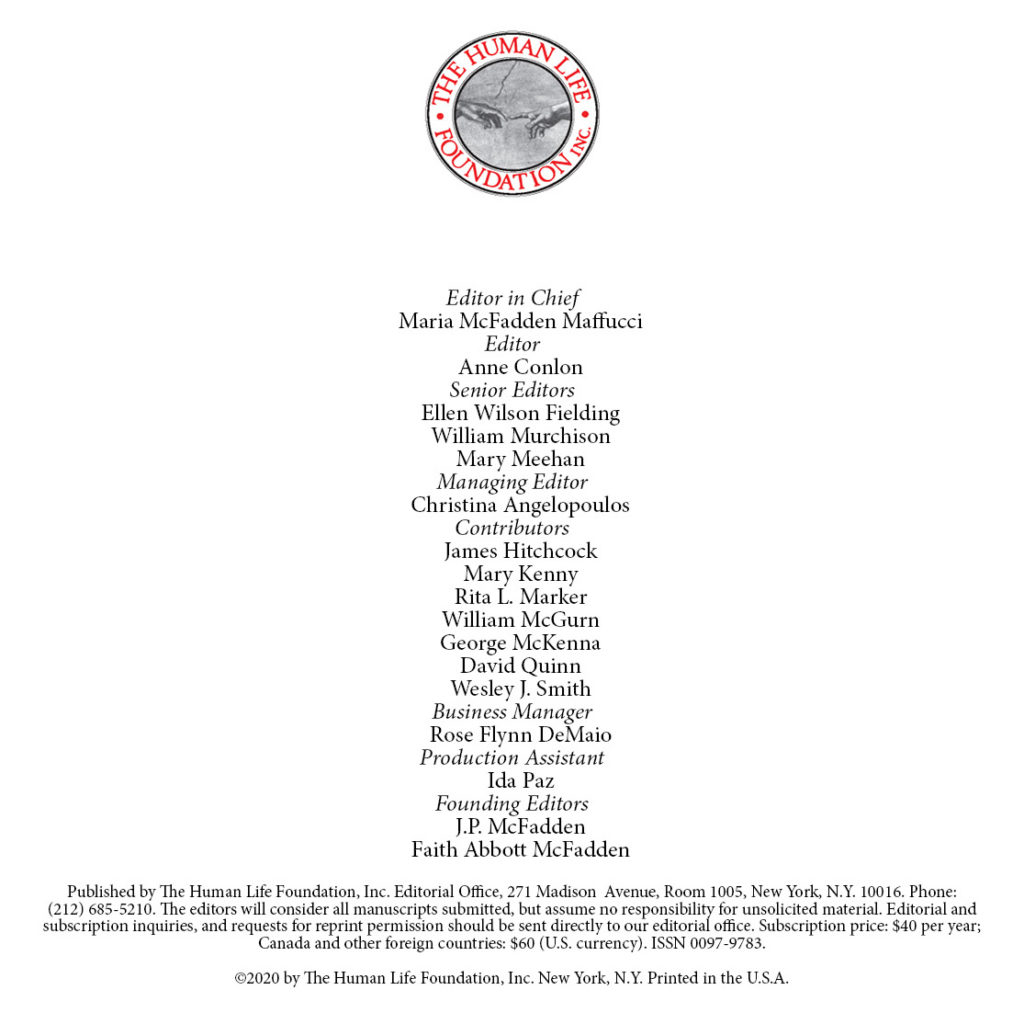|
|
 - About this issue . . .
. . . The journal you hold offers respite from the media’s frenzied, endless loop of “breaking news.” Instead, the articles collected here afford readers the opportunity to explore, along with our eminent authors, matters of human life—how it begins, how marvelous it is!—and whether or not it is protected in law, medicine, and science, or rightly valued in our communities or even in our churches.
We think carefully here: As new contributor Rev. Canon Victor Austin writes: “Falsehoods, even in a good cause, remain false, and in the long run they will damage the good they try to uphold.” His fascinating “On Twinning” (p. 15) is a deep dive into the biological phenomenon of identical twinning and the questions it poses for the “claim that it is at the moment of fusion of sperm and egg—the beginning of the embryo—that the life of a unique human being begins.” Though this is his first Review article, Rev. Austin has a decades-long history with us, starting in the 1980s when his late wife—subject of his poignant book Losing Susan: Brain Disease, the Priest’s Wife, and the God Who Gives and Takes Away (2017, Baker Publishing Group), joined the staff. Mrs. Austin fondly remembered J.P. McFadden, our founding editor, after his death in 1998: a “hard-punching, fiery-hearted journalist” who “began a journal called the Human Life Review, which was the brain of the anti-abortion movement. He published my first offering to the Review (“Health for the New Woman,” Fall 1981) and gave me a job as a proofreader in his tiny eighth-floor office, filled with tobacco smoke and ideas.” (We remind you that you can easily find Susan Austin’s articles as well as Rev. Austin’s Invocation from our 2013 Great Defender of Life Dinner in our archives, available on our website, at www.humanlifereview.com).
Mr. Lyle Strathman is a true newcomer; his “A Case for the Revocation of Roe v. Wade” (p. 10) came, as editor Anne Conlon writes in her Introduction, as an unannounced “gem,” a fresh take on the pivotal decision also discussed in our lead article by senior editor William Murchison. In “The Not-So-Notorious R.B.G.,” Murchison, with his usual flair, reminds us that the late Justice Ginsburg, while a whole-hearted advocate of reproductive “rights,” was decidedly not a fan of the specifics of the Roe ruling. As we go to press, “Victorious ACB,” as the Wall Street Journal dubbed our new Supreme Court Justice Amy Coney Barrett, is taking over Justice Ginsburg’s chambers—a bright moment in a dark year, especially for working mothers (see “Thank you Amy!” by Mary Kay Barket, p. 84).
Our thanks for reprint permission go to The Catholic Thing for Fr. Gerald Murray’s column (Appendix A, p. 93) on a book just out by our contributor George Marlin: Mario Cuomo: The Myth and the Man (St. Augustine Press); and Rita Marker and the Patients Rights Council for Marker’s important column: “Time to End Solitary Confinement in Nursing Homes” (Appendix B, p. 95). Thanks always to Nick Downes for giving us the needed relief a fit of giggles brings. Is there anyone alive not anxious to say goodbye and good riddance to 2020? And yet, sweethearts got married, babies arrived, families found that quarantine caused deeper connections. As we complete 46 years of publishing, we wish all our readers renewed trust and hope for better days ahead.Maria McFadden Maffucci
Editor in Chief
- They battled wits on the bench but were, as Justice Ginsburg remarked in a statement after Justice Scalia’s death in 2016, “best buddies” who once sang a duet on stage in an opera inspired by their decades-long friendship. News accounts of her death this past September duly noted the “unlikely” bond, an amusing aside in otherwise adulatory catalogs of Ginsburg’s legal-ceiling smashing. Senior editor William Murchison, however, “miles away from the fans and encouragers of the Notorious R.B.G.,” is looking to understand this close relationship, which, he suspects, was sustained by more than a love of opera. “Mr. Justice Scalia,” Murchison writes in “The Not-So-Notorious R.B.G.,” our lead article, “wasn’t around to emote over the death of his friend Madam Justice Ginsburg, but it has occurred to me that he may have found in her something more than a Marilyn Horne fan; to wit, a colleague of intellectual depth comparable to his own, capable of discerning points others might miss in the hurly-burly of legal conflict.”
Read More
|
